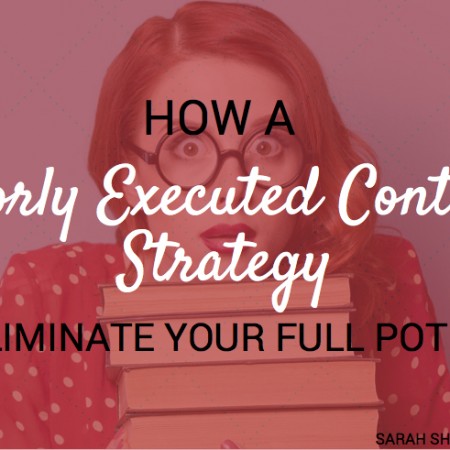
How a Poorly Executed Content Strategy Can Eliminate Your Full Potential
Sarah Shade is one of our Content Specialists at Express Writers.
Content strategy.
You and I both (as good Internet marketers) know all about these by now.
Without one, it’s like trying to find a black cat in a dark room without a light bulb.
But did you know that a poorly executed content strategy can be even more harmful than not having one at all?
Even Harvard Business Review notes that most management professionals agree that a mediocre strategy that is executed well trumps a great strategy that is executed poorly.
In the realm of content strategy this is usually the case, although some exceptions to the rule do stand out.
The How-To’s of Content Strategy Development
In order for a content strategy to be successful, it must first be properly defined. Far too often, marketing professionals underestimate how important it is to undertake the basic steps of content strategy development. Like any good plan, a well-developed content strategy takes time and effort and no small amount of consideration. Even Forbes notes that even though content marketing can be complicated, it’s not in your best interests to put it on the back burner or ignore it altogether.
Getting to Success – When Your Content Strategy Comes Together
It’s a wonderful feeling to realize that your content strategy is coming together. All your key performance indicators are pointing towards a steady increase in traffic and your company’s name is on the public’s tongue. They know who you are and what you stand for. You’ve even managed to convince users to evangelize for you and things could not be better. In a perfect world, this would be what you’d come to expect from content marketing strategies. The truth of the matter is that this is the exception, rather than the rule. There are so many things that could possibly go wrong with a content strategy that ends up with it performing far worse than it set out to do, or even doing the opposite and driving consumers away from your site.
How Content Strategies Fail
If a content strategy is not delivering to its fullest potential the fault may lie in one of two places. Firstly, in the initial setup of the content marketing strategy there could have been a number of problems with how you approached the problem. On the other side of the coin are the problems that occur with the strategy that happen after its implementation. Both planning-level snafus and implementation level mistakes can lead to a content strategy failing. Let’s take a closer look at where the process seems to break down in these two key areas.
4 Major Planning Level Failures
In planning level failure, a content strategy is doomed from the time it’s conceptualized. Although this seems like a bleak prospect, it is usually the case when an unskilled content strategy team tries to develop a strategy plan without having a proper grasp of planning principles. There are a number of key areas where this problem can persist and lead to failure for the strategy, such as:
1. Wrong Target Demographic
While you would expect companies to know their own target demographic, you would be shocked to see how many of them aim their content strategy at a demographic that it doesn’t work for, while ignoring the demographic that it would appeal to best.
2. Not Budgeting Enough
Having a budget is a good thing in a corporate setting because it gives you a figure to work with regarding what you’re allowed for purchasing new content. However, budgeting too little can make you sacrifice quality in order to meet your quota.
3. No Clear Distribution Channels
Defining your distribution channels enables your content strategy to perform the way it was designed to. The distribution channels you choose should be the ones where your target demographic exists in large numbers.
4. Being Out Touch with your Audience
Content marketing has a marked focus on the audience you are creating content for. If you don’t know what drives your audience, what motivates them and what makes them take action, then you need to find out before embarking on a content marketing campaign.
Planning level failure isn’t the end of the world for a content strategy, however. Even though these things can limit the success (or even reverse it) for a content strategy, it is likely that the content management team will realize what’s going on and correct themselves before they get too far into content production.
Four Implementation Level Failures
This is where things get kind of complicated. At planning level failure it is a simple matter of fixing the behind-the-scenes work and redirecting resources where they have to go. When it comes to implementation level failure, things that go wrong here can severely damage the business image in the public eye. Depending on what goes wrong the impact could range from minor to catastrophic. Implementation level failure can include problems such as:
1. Failure to Streamline Content
Although not a capital sin, failing to streamline your already produced content can lead to users leaving your site as they get there. Things such as consistent typography, working external links and relevant topics of discussion all fall under this broad heading. Properly vetting your content through an audit is a great way to deal with this problem, although it can be time consuming.
2. Not Engaging your Audience Properly
The aim of content when developed in tandem with a strategy is to engage the audience so that they build a bond of loyalty with your brand or company. In order to engage your audience properly, you need to develop content that highlights hot-button topics and then discuss these over your comment section or on social media. Remember when discussing these things with your audience, it is recommended that you have a non-aggressive tone, even if members of the audience disagrees with your point of view.
3. Poor Quality Content
Probably the number one problem that strategists have when it comes to content marketing is having low quality content taking up space on their sites. One thing that most content gurus expound on ad nausea is that quality is far superior to quantity. If you produce one good content piece a day, it’s better than having twenty medium-to-low quality content pieces. Raising the quality of your content to high is essential to the success of any content strategy.
4. Content not SEO Optimized
In 2006, it was estimated that as much as 93% of all traffic originated from search engines. That’s a massive figure no matter how you slice it. That’s why your content needs to be optimized for SEO purposes. Good SEO optimization ensures that you get the most benefit out of your content and increase the amount of relevant traffic that search engines send your way. Having un-optimized content will mean you’re paying for good content that just doesn’t perform because it doesn’t have an audience to impact.
KMart on Black Friday: An Example of Social Media Failure
In 2013, KMart as eager to show off that they would be open for business on Black Friday, the biggest shopping day of the year. However, many of their Twitter followers criticized the decision, accusing the company of putting profits before family.
A company that had user engagement as one of its core tenets would have been able to diffuse this situation easily enough by showing how their workers were volunteering to work on that day.
However, with a brilliant combination of poor grammar, caveman-like sentence structure and a canned response, KMart managed to alienate its users and make them even more undesirable as a shopping location to a large swathe of their clientele.
@jennbrazen Kmart is staffing w/ teams & seasonal associates when possible, giving them opportunity to make extra money during holiday.
— Kmart (@Kmart) November 6, 2013
JP Morgan Answers Questions on Twitter
KMart’s problem was that it probably had an inexperienced person running their Twitter account or that they just didn’t consider Twitter to be such a big deal. JP Morgan, however, knows how much or a big deal Twitter is when it comes to content marketing. They hosted a session where users would chime in with questions for the financial juggernaut that they hoped would be stimulating conversation about the economy of the country. They clearly underestimated how little love Twitter users had for them, from the responses.
It’s a #TwitterTakeover: We'll host our 1st live Q&A on leadership & career advice w/a leading $JPM exec on 11/14. Use #AskJPM to submit a Q
— J.P. Morgan (@jpmorgan) November 6, 2013
https://twitter.com/dudestravel/status/622758693713612800
https://twitter.com/hcwcars/status/611478824845471744
At least they realized how out of touch they were with the audience before it got too out of hand.
Tomorrow's Q&A is cancelled. Bad Idea. Back to the drawing board.
— J.P. Morgan (@jpmorgan) November 14, 2013
Avoiding Content Strategy Failure
To be completely honest, no content strategy will succeed 100% of the time.
Just like everything that deals with human nature, the success of a content strategy depends upon timing and the willingness of the public to accept it.
Content strategies that would have been very successful in 2012 would leave audiences scratching their heads in 2015.
To minimize the margin of failure, you need to be aware of your audience. You need to understand what they need and the best way to provide it for them. Most importantly, you need to know how your audience views your company or brand to avoid making massive blunders that could affect your corporate image. When all is said and done, the final success of your content strategy lies in the hands of your audience.

